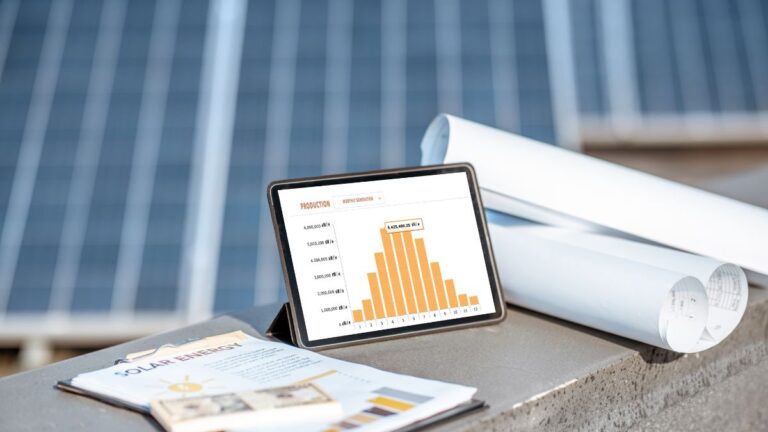15 Effective Ways to Reduce Environmental Impact of Solar Power
Are you concerned about the environmental impact of solar power? Discover 15 effective ways to reduce its impact and create a sustainable future. By optimizing panel efficiency, implementing sustainable manufacturing practices, and minimizing water usage, we can make a significant difference.
Additionally, improving end-of-life management and maximizing the use of renewable energy will further reduce our ecological footprint. Let’s come together and support responsible solar power planning and research for greener technologies.
Together, we can make a positive change for our planet.
Key Takeaways
- Regularly maintain and clean solar panels to remove dirt and debris.
- Optimize installation techniques to ensure correct angle and ample sunlight exposure.
- Implement tracking and monitoring systems to promptly address issues.
- Invest in research and development to enhance solar panel efficiency and performance.
Optimize Solar Panel Efficiency
To optimize solar panel efficiency, you can start by properly maintaining and cleaning your panels on a regular basis. By doing so, you can ensure that your panels are free from dirt, debris, and other obstructions that can hinder their performance.
Additionally, improving installation techniques can also contribute to maximizing efficiency. Ensuring that the panels are installed at the correct angle and in a location that receives ample sunlight can significantly enhance their energy production.
Regularly monitoring and optimizing maintenance procedures is another crucial step. This includes inspecting for any damage, checking for loose connections, and promptly addressing any issues that arise.
Reduce Energy Consumption in Manufacturing
To reduce energy consumption in solar panel manufacturing, you can implement sustainable manufacturing practices and focus on efficiency in production processes.
By using renewable energy sources, such as solar power, in the manufacturing facilities, you can significantly reduce the carbon footprint.
Additionally, optimizing production processes and investing in energy-efficient equipment can further reduce energy consumption and minimize environmental impact.
Sustainable Manufacturing Practices
By implementing sustainable manufacturing practices, you can significantly reduce energy consumption in the manufacturing process of solar power. Here are five key ways to achieve this:
- Use Sustainable Materials: Opt for eco-friendly materials such as recycled metals and plastics. These materials have a lower energy footprint and reduce the need for resource extraction.
- Implement Energy-Efficient Technologies: Incorporate energy-efficient machinery and equipment to minimize energy consumption during the manufacturing process.
- Maximize Renewable Energy Integration: Install solar panels or use wind power to generate clean and renewable energy to power your manufacturing facility.
- Optimize Production Processes: Streamline manufacturing processes to eliminate waste, reduce energy usage, and improve overall efficiency.
- Encourage Employee Engagement: Promote sustainability practices among your workforce by educating them about energy conservation and involving them in finding innovative solutions.
Efficiency in Production Processes
As you continue to implement sustainable manufacturing practices, it is important to focus on efficiency in production processes to further reduce energy consumption in solar power manufacturing. By improving material sourcing and enhancing resource efficiency, you can significantly decrease the environmental impact of solar power production.
One way to improve material sourcing is by using recycled materials in the manufacturing process. This not only reduces the energy required for extracting and processing raw materials but also decreases waste and promotes a circular economy.
In terms of resource efficiency, optimizing production processes can lead to significant energy savings. This can be achieved by implementing lean manufacturing techniques, such as reducing waste through better inventory management and streamlining production flows.
Additionally, investing in energy-efficient equipment and technologies can help reduce energy consumption during the manufacturing process. Switching to renewable energy sources, such as solar power, for powering manufacturing facilities can also contribute to a more sustainable production process.
By continuously striving for efficiency in production processes, you can minimize the energy consumption and environmental impact of solar power manufacturing, while also fostering a sense of belonging to a community that values sustainability.
Implement Sustainable Manufacturing Practices
To implement sustainable manufacturing practices, you can start by optimizing energy efficiency and reducing waste throughout the production process. Here are five ways to achieve this:
- Invest in energy-efficient equipment: Upgrade your machinery to more energy-efficient models that consume less electricity and reduce greenhouse gas emissions.
- Implement waste reduction strategies: Analyze your production process and identify areas where waste can be minimized. This can include recycling materials, reusing packaging, and finding ways to repurpose by-products.
- Promote employee engagement: Educate and involve your employees in sustainability initiatives. Encourage them to suggest ideas for improving energy efficiency and waste reduction.
- Source materials responsibly: Choose suppliers who prioritize sustainable practices and offer environmentally friendly materials. This ensures that your manufacturing process aligns with your sustainability goals.
- Regularly monitor and measure performance: Implement a system to track and measure your energy usage, waste generation, and greenhouse gas emissions. This data will help identify areas for improvement and set targets for reducing environmental impact.
Minimize Water Usage in Solar Panel Production
To minimize water usage in solar panel production, you can implement efficient manufacturing techniques that reduce water consumption. By implementing water saving techniques and incorporating water recycling in the production process, you can significantly reduce the amount of water used and minimize the environmental impact of solar panel production.
One way to achieve this is by adopting closed-loop systems that recycle water used in the manufacturing process. This involves treating and reusing water instead of disposing of it, thereby reducing the overall water consumption. Additionally, optimizing the manufacturing processes can help minimize water usage. This can be done by implementing advanced technologies and equipment that require less water for cleaning and cooling purposes.
Another effective approach is to encourage suppliers to adopt water-saving measures in their production processes. By working closely with suppliers and promoting sustainable practices, you can further reduce the water footprint of solar panel production.
Implementing these water-saving techniques and promoting water recycling in production can greatly contribute to reducing the environmental impact of solar panel manufacturing. By actively addressing water usage in the production process, we can ensure a more sustainable future for solar power.
Improve End-of-Life Management for Solar Panels
You can improve the end-of-life management for solar panels by implementing effective recycling and disposal practices. Here are five ways to achieve that:
- Improve recycling infrastructure: Invest in the development and expansion of recycling facilities specifically designed for solar panels. This will ensure that panels are properly dismantled and recycled, reducing the amount of waste that ends up in landfills.
- Incentivize solar panel recycling: Create financial incentives for individuals and businesses to recycle their old solar panels. This can be done through tax credits, rebates, or subsidies, encouraging responsible disposal practices.
- Educate consumers: Raise awareness about the importance of proper end-of-life management for solar panels. Provide information on recycling options and the environmental benefits of recycling, empowering consumers to make sustainable choices.
- Collaborate with manufacturers: Work with solar panel manufacturers to design products that are easier to recycle. This can include using materials that are more readily recyclable and implementing standardized labeling to aid in the recycling process.
- Implement regulations: Enforce regulations that require the proper disposal of solar panels at the end of their life cycle. This will ensure that all stakeholders are held accountable for managing the environmental impact of solar panel waste.
Enhance Recycling and Reuse of Solar Panel Materials
By enhancing the recycling and reuse of solar panel materials, you can significantly reduce their environmental impact. Recycling initiatives and adopting a circular economy approach are crucial in achieving this goal.
Recycling solar panels allows for the recovery of valuable materials, such as silicon, silver, and aluminum, which can be used to manufacture new panels. This reduces the need for virgin materials extraction and minimizes the energy and water consumption associated with their production.
Additionally, recycling helps to divert electronic waste from landfills, preventing the release of harmful substances into the environment. Reusing solar panel components, such as inverters and mounting systems, further extends their lifespan and reduces waste.
Implementing comprehensive recycling programs and supporting research and development in panel recycling technologies are vital steps towards a more sustainable solar industry.
| Recycling Initiatives | Circular Economy Approach | Benefits |
|---|---|---|
| Efficient collection and sorting of used panels | Promoting closed-loop systems and material reutilization | Reduces resource consumption and waste |
| Investing in advanced recycling technologies | Encouraging product design for recyclability and modularity | Enables efficient recovery of valuable materials |
| Establishing partnerships with manufacturers and recyclers | Implementing take-back programs and incentivizing recycling | Improves end-of-life management and reduces environmental impact |
Decrease Carbon Emissions in Solar Power Generation
To decrease carbon emissions in solar power generation, you can focus on cleaner energy production and sustainable solar solutions.
By utilizing advanced technologies and efficient manufacturing processes, solar panel production can be optimized to minimize carbon footprints.
Additionally, investing in research and development for new materials and improved energy storage systems can further reduce the environmental impact of solar power generation.
Cleaner Energy Production
One effective way to reduce carbon emissions in solar power generation is by using cleaner energy production methods. By implementing these methods, we can make significant strides in reducing the environmental impact of solar power.
Here are five key strategies to achieve cleaner energy production in the solar industry:
- Increasing the efficiency of solar panels: Improving the efficiency of solar panels will result in more electricity being generated for a given amount of sunlight, thereby decreasing the need for additional panels and reducing carbon emissions associated with their production.
- Promoting the use of advanced manufacturing processes: Adopting advanced manufacturing techniques can minimize energy consumption and waste during the production of solar panels, making the entire process more environmentally friendly.
- Investing in research and development: Continued investment in research and development will lead to the discovery of new materials and technologies that can enhance the sustainability of solar power generation.
- Enhancing recycling and end-of-life management: Developing efficient recycling processes for solar panels will help reduce the environmental impact of their disposal and promote the circular economy.
- Implementing renewable energy-powered manufacturing facilities: Using renewable energy sources, such as wind or hydropower, to power the manufacturing facilities for solar panels can significantly reduce carbon emissions associated with their production.
Sustainable Solar Solutions
Achieve a significant decrease in carbon emissions in solar power generation through the implementation of sustainable solar solutions. To address this issue, smart grid integration and community solar initiatives play a crucial role.
By integrating solar power systems with smart grids, we can optimize the distribution and consumption of solar energy. This allows for better management of energy flow, reducing wastage and increasing overall efficiency.
Additionally, community solar initiatives enable multiple households or businesses to collectively invest in and benefit from a shared solar energy system. This not only promotes renewable energy adoption but also fosters a sense of community and collaboration.
By embracing these sustainable solar solutions, we can reduce carbon emissions, create a more resilient energy system, and contribute to a cleaner and greener future.
Minimizing Carbon Footprints
You can significantly decrease carbon emissions in solar power generation by implementing strategies to minimize your carbon footprint. Here are five effective ways to achieve this:
- Invest in carbon offsetting: By purchasing carbon offsets, you can neutralize the emissions produced during the manufacturing and installation of solar panels. This helps to balance out the carbon emissions associated with your solar power system.
- Promote sustainable transportation: Encourage the use of electric vehicles or bicycles for commuting to reduce carbon emissions from transportation. Additionally, support public transportation to further reduce the carbon footprint of your solar power system.
- Optimize energy efficiency: Implement energy-efficient practices in your home or business to minimize overall energy consumption. This reduces the demand for electricity generated by your solar panels, ultimately reducing carbon emissions.
- Proper waste management: Ensure proper disposal and recycling of solar panels at the end of their lifespan. This prevents harmful chemicals from entering the environment and contributes to a more sustainable solar power system.
- Educate and raise awareness: Spread knowledge about the importance of minimizing carbon emissions in solar power generation. Encourage others to adopt sustainable practices and make informed choices to reduce their carbon footprint.
Promote Wildlife-friendly Solar Power Installations
To minimize the environmental impact of solar power, it’s essential to promote the installation of wildlife-friendly solar power systems.
While solar energy is a clean and renewable source of power, the traditional installation of solar panels can have negative effects on wildlife and ecosystems.
However, by implementing certain measures, we can ensure that solar power installations are compatible with wildlife protection and ecosystem preservation.
One effective measure is to design solar power systems that minimize their impact on wildlife habitats. This can be achieved by incorporating features such as wildlife-friendly landscaping, bird and bat boxes, and pollinator-friendly plants in and around solar installations.
Additionally, careful consideration should be given to the location of solar farms to avoid disrupting animal migration routes or important habitats.
Utilize Sustainable Land Use for Solar Farms
To effectively utilize land for solar farms, optimal land allocation strategies should be implemented. This includes identifying suitable locations that maximize solar energy generation while minimizing environmental impact.
Additionally, implementing biodiversity conservation measures within and around solar farms can help protect and preserve local ecosystems, supporting wildlife and plant species diversity.
Optimal Land Allocation
Sustainable land use is essential for maximizing the efficiency and minimizing the environmental impact of solar farms. By implementing optimal land management practices and prioritizing ecosystem preservation, we can create a harmonious balance between renewable energy production and environmental protection.
Here are five key actions to ensure optimal land allocation for solar farms:
- Conduct thorough site assessments to identify suitable locations that minimize disturbance to sensitive ecosystems.
- Adopt land use strategies that prioritize the use of brownfields, rooftops, and other already developed areas to minimize land conversion.
- Implement proper land management techniques, such as erosion control and reforestation, to restore and maintain the ecological integrity of the surrounding landscape.
- Promote biodiversity by incorporating native vegetation and creating wildlife-friendly habitats within solar farm boundaries.
- Encourage community engagement and collaboration to ensure that local perspectives and concerns are addressed throughout the land allocation process.
Biodiversity Conservation Measures
By incorporating sustainable land use practices, you can effectively implement biodiversity conservation measures for solar farms. One way to achieve this is by carefully selecting the location for solar farms. Conducting thorough environmental assessments prior to construction can help identify areas with low biodiversity value or high sensitivity, minimizing the impact on important habitats and species.
Additionally, utilizing a mix of native vegetation, such as pollinator-friendly plants, in and around solar farms can provide important habitats and resources for local wildlife. Creating wildlife corridors and buffer zones can also help maintain connectivity between different habitats and reduce fragmentation.
Implementing these measures not only supports local biodiversity but also promotes ecosystem services, such as pollination and natural pest control, which are crucial for sustainable agricultural practices. Sustainable land use practices are essential for ensuring the coexistence of solar farms and biodiversity conservation.
Implement Noise Reduction Measures in Solar Power Plants
Implement noise reduction measures in solar power plants to minimize the environmental impact of the technology. Here are some effective strategies:
- Implementing acoustic barriers: Installing physical barriers around solar power plants can help reduce noise transmission to surrounding areas.
- Utilizing sound absorbing materials in solar power plants: Incorporating materials that absorb sound waves can help mitigate noise emissions from the equipment.
- Exploring noise canceling technologies in solar panel installations: Investigating the use of advanced technologies to actively cancel out noise generated by solar panels.
- Assessing the impact of noise on local wildlife: Conducting studies to understand how noise pollution from solar power plants affects wildlife and implementing measures to protect their habitats.
- Implementing noise reduction policies and regulations: Enforcing strict guidelines to limit noise emissions from solar power plants and ensure compliance with noise standards.
Enhance Solar Power System Design for Minimal Environmental Impact
To minimize the environmental impact of solar power, enhance the design of your solar power system. One way to achieve this is by implementing energy efficient designs and eco-friendly installations.
Energy efficient designs focus on maximizing the amount of energy generated by the system while minimizing energy losses. This can be achieved through the use of high-quality components, such as solar panels and inverters, that have high conversion efficiencies. Additionally, optimizing the orientation and tilt angle of the solar panels can also help maximize energy production.
Eco-friendly installations involve reducing the use of harmful materials in the construction and operation of the system. For example, using environmentally friendly materials for mounting structures and wiring can minimize the system’s carbon footprint.
Maximize Use of Renewable Energy in Solar Power Production
To further reduce solar power’s environmental impact, you can maximize your use of renewable energy in the production process. Here are some key ways to achieve this:
- Maximize Energy Storage: Implementing efficient energy storage systems allows you to store excess solar energy generated during the day for use during times when the sun isn’t shining. This reduces the reliance on traditional power sources during low production periods.
- Promote Community Solar Projects: Encourage the development of community solar projects, where multiple households or businesses share the benefits of a single solar energy system. This promotes the use of renewable energy on a larger scale and allows individuals who may not have suitable roof space for solar panels to still participate.
- Invest in Wind Power: Integrating wind power into your energy mix alongside solar power can help diversify your renewable energy sources and increase overall energy production.
- Utilize Biomass Energy: Biomass energy, derived from organic matter such as crop residues or wood pellets, can be used to generate heat or electricity. Incorporating biomass energy into your solar power production process further reduces reliance on fossil fuels.
- Explore Geothermal Energy: Geothermal energy harnesses the natural heat from the Earth’s core to generate electricity. By tapping into this renewable energy source, you can further reduce your carbon footprint and contribute to a more sustainable energy system.
Reduce Environmental Impact of Solar Power Infrastructure
To minimize the environmental impact of solar power infrastructure, you can start by ensuring proper disposal and recycling of solar panels. Solar panels contain materials that can be harmful to the environment if not disposed of correctly. By promoting the responsible recycling of solar panels, you can reduce waste management issues and prevent the release of toxic substances into the environment.
Additionally, promoting energy conservation in the construction and operation of solar power infrastructure can further minimize its environmental impact. This can be achieved by optimizing the design and placement of solar panels to maximize energy efficiency, as well as implementing energy-saving technologies in the infrastructure itself.
Promote Responsible Solar Power Project Planning
Promote responsible planning for solar power projects by considering environmental factors and incorporating sustainable practices. To minimize ecological disruption and foster community engagement, here are five key considerations:
- Site selection: Choose locations that have minimal impact on natural habitats, such as brownfields, rooftops, or already disturbed land.
- Biodiversity preservation: Design projects that protect and enhance local ecosystems, considering the needs of native species and incorporating green spaces.
- Environmental impact assessment: Conduct thorough studies to identify potential environmental risks and develop mitigation strategies.
- Stakeholder engagement: Involve local communities, environmental organizations, and indigenous groups in the planning process to ensure their concerns are heard and addressed.
- Sustainable construction practices: Implement measures to reduce waste, conserve water, and minimize energy consumption during construction.
Support Research and Development for Green Solar Technologies
To effectively reduce the environmental impact of solar power, it’s crucial to support research and development for green solar technologies.
By allocating funding towards sustainable solar tech, advancements can be made in improving the efficiency and sustainability of solar panels and related equipment.
Additionally, promoting eco-friendly innovation within the solar industry will drive the adoption of cleaner and more environmentally friendly solar energy solutions.
Funding Sustainable Solar Tech
Support the research and development of green solar technologies to fund sustainable solar tech. Here are some funding strategies and government incentives that can help achieve this goal:
- Tax Credits: Governments can provide tax credits to individuals and businesses that invest in green solar technologies. These credits can significantly reduce the cost of installation and encourage more people to adopt solar power.
- Grants and Subsidies: Governments can offer grants and subsidies to support research and development in the solar industry. This financial assistance can help fund innovative projects and promote the advancement of green solar technologies.
- Public-Private Partnerships: Collaboration between the government and private companies can lead to increased funding for sustainable solar tech. By pooling resources and expertise, these partnerships can accelerate research and development efforts.
- Crowdfunding: Individuals can contribute to the development of green solar technologies through crowdfunding platforms. This enables people to directly support projects that align with their values and contribute to a more sustainable future.
- International Funding Initiatives: Governments and organizations can establish international funding initiatives to support the research and development of green solar technologies worldwide. These initiatives can provide financial assistance and encourage collaboration among countries to address global environmental challenges.
Promote Eco-Friendly Innovation
Invest in sustainable solar tech research and development to foster eco-friendly innovation in the solar industry. By investing in eco-friendly innovations and sustainable technology, we can make significant strides in reducing the environmental impact of solar power.
Supporting research and development for green solar technologies is crucial to finding more efficient and sustainable ways to harness the power of the sun. To illustrate the importance of this investment, consider the following table:
| Benefit | Description |
|---|---|
| 1. Environmental Impact | Eco-friendly innovations can greatly reduce the carbon footprint of solar power, helping to combat climate change and preserve our planet for future generations. |
| 2. Cost Efficiency | Sustainable technology can improve the efficiency of solar power systems, making them more cost-effective and accessible to a wider range of consumers. |
| 3. Technological Advancements | Research and development in green solar technologies can lead to breakthroughs in energy storage, grid integration, and other areas, advancing the overall capabilities of solar power. |
Investing in sustainable solar tech research and development is a proactive step towards a cleaner and more sustainable future. By supporting eco-friendly innovations, we can drive positive change in the solar industry and contribute to a healthier planet.
Conclusion
You can make a significant impact on reducing solar power’s environmental impact by implementing these 15 effective strategies.
One interesting statistic to note is that optimizing solar panel efficiency by just 1% can save enough energy to power over 1 million homes for a year.
By taking action and adopting sustainable practices, we can ensure a greener future for generations to come. Let’s harness the power of the sun responsibly and make a positive difference for our planet.






